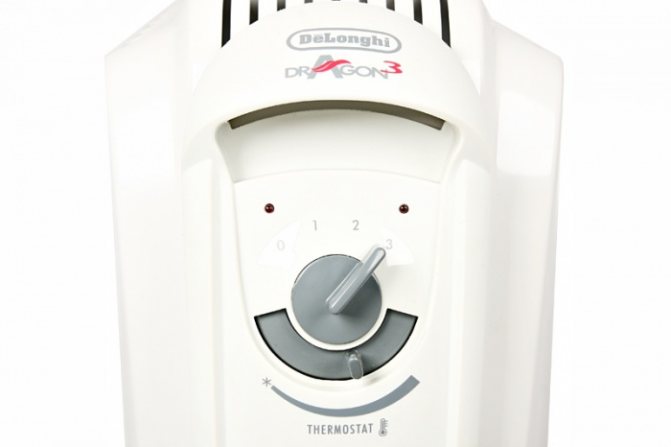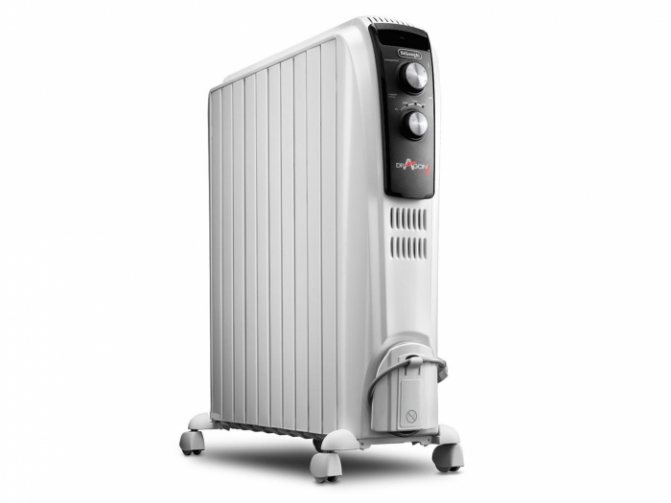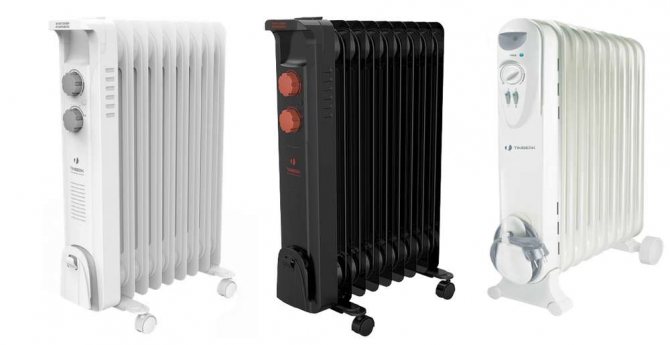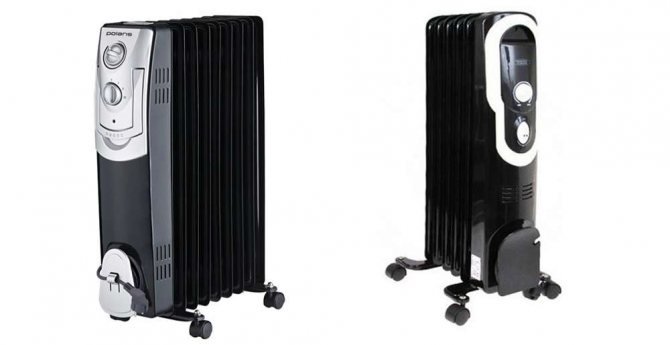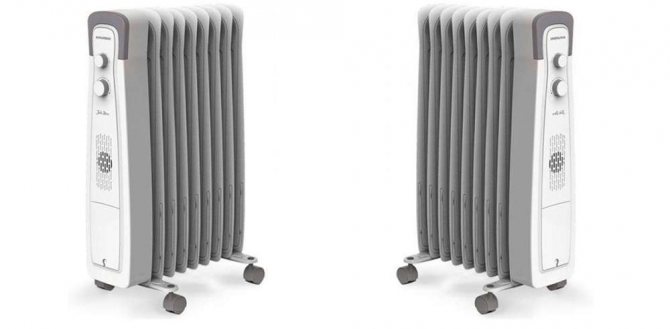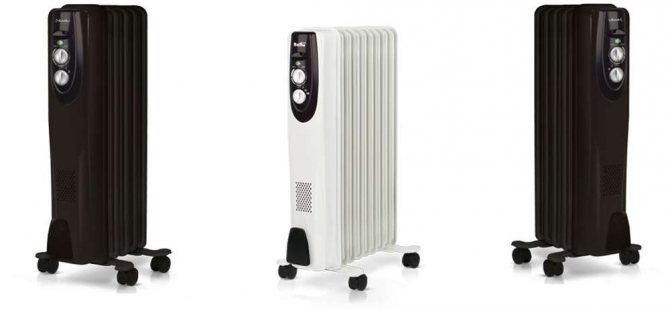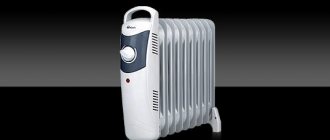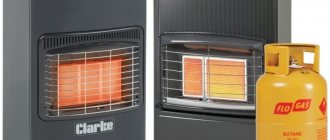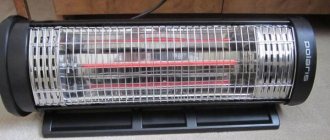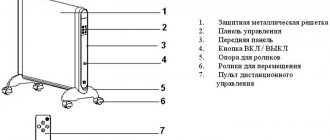An oil heater is a fairly compact, mobile device similar in appearance to a conventional radiator. The heater has a decent power and is able to effectively warm a room in an apartment, private or country house. But sometimes, for some reason, a leak may occur in the heater case, which will need to be repaired, and then add oil to the radiator. All this can be done by yourself. But you should know what kind of oil should be in the oil heater. Indeed, its performance and heating efficiency depend on this.
Design and principle of operation
The design of the oil cooler is quite simple. It consists of a body filled with oil and one or more heating elements. The heater is controlled by the existing regulator. It allows you not only to turn the device on or off, but also to adjust the intensity of work. Modern models of oil heaters can be additionally equipped with:
- fan;
- timer;
- remote control.
Attention: The oil in the heater housing makes it possible to achieve high-quality heating of the room, has a positive effect on the safety of the device and makes it possible to save money. In terms of heat conductivity, oil is significantly superior to air.

Read more about the inverter heater here.
The principle of operation of an oil heater is as follows: heating elements immersed in oil heat up as a result of which the temperature of the filler rises, which transfers heat to the room through the body. Due to the fact that heating elements are cooled in oil rather quickly, oil heaters have high efficiency. Many modern models of oil heaters are equipped with built-in fans. With their help, a faster rate of heating the room is provided.
Oil radiators are reliable enough, but they can also break. Breakdowns vary, but one of the most common is oil leaks. In the event of such a malfunction, it is necessary not only to eliminate the leak, but also to add oil to the heater.
According to user reviews and its composition, transformer oil is best suited for these purposes. Moreover, it is quite affordable and it will not be difficult to find it.
Buying a quality oil cooler
An oil heater is used as an additional source of heat in living quarters. Due to its mobility and light weight, it is easy to transport, and therefore this equipment is very often bought for a summer residence or a country house. Choosing an oil heater, pay attention to its power, section thickness, weight and additional functions. An attribute of a quality device is the presence of a thermostat and various controllers that protect the radiator from overheating and working in the wrong position.
Like any device, the radiator can break. Consumers often have a question about how to fix the heating element, how to change the oil in the heater, how to solder the case. In this case, you cannot repair the device yourself. It is better to contact the service center for help. This guarantees a high quality of repair work and, consequently, a long service life of the heater.
From the author: hello dear friends! The oil heater is one of the most popular types of auxiliary heating equipment.It has a lot of advantages: high efficiency, unpretentious operation, long service life. Its installation does not require effort, and the cost does not cause fear in any category of the population.
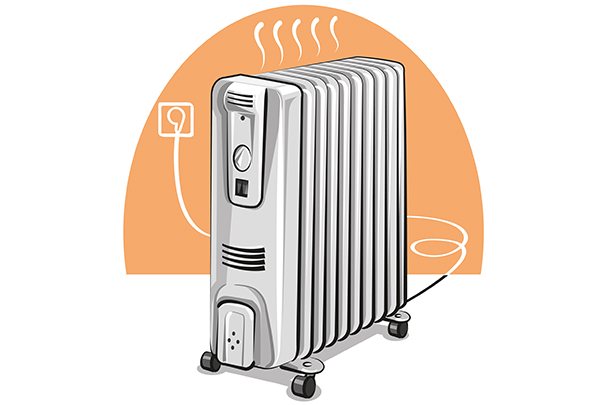

Nevertheless, sometimes problems still arise that you want to cope with on your own, so as not to attract masters and not spend money on purchasing a new device. Quite often, it is necessary to change the "stuffing" of the device. To carry out this procedure, it is important to know what kind of oil is in the oil heater, and how it can be replaced so that the device can continue to function fully.
Transformer oil
Transformer oil is made from petroleum by distillation. It has a low viscosity and good cleaning properties. The oil boils at a temperature of 300 degrees. It is intended for pouring into circuit breakers, transformers and reactor devices. Due to its properties, it can also be poured into an oil heater.
The composition of transformer oil depends on the original composition of the raw materials from which it is made. It may have some differences depending on the field from which the oil was produced.
On average, transformer oil, which can be poured into a heater, has a service life of no more than 20 years. But it must be unused before.
Attention: The filled oil must have the necessary certificates from the manufacturer. They must confirm that the technical oil is free of any additives, gases and moisture.
This fluid, due to its characteristics, is able to operate even at low temperatures. The minimum mark can be 45 degrees. Due to its low viscosity, it is able to efficiently dissipate heat.
Heater design
First, we need to figure out what we have to deal with. An oil heater consists of several elements:
- body. It is a sealed metal product. Usually it is covered with a special powder paint, which prevents the destruction of the material due to exposure to high temperatures;
- tubular electric heater. Located at the bottom of the case. Fully covered with oil in normal operation. Heating this filler from below, the heating element stimulates the onset of convection flows inside the equipment. As a result, the device heats up evenly and equally evenly gives off heat to the room;
- control system. It consists of a switch as well as a power mode switch. The latter is not available on all models, but its presence significantly increases the level of comfort of people, since it allows you to adjust the air temperature depending on current needs;
- safety system. It includes an overheating sensor and a rollover sensor. The first monitors the temperature of the oil. If it starts to boil, it is fraught with several negative consequences at once. First, equipment burnout can occur. Secondly, the boiled oil releases a lot of air, which begins to "expand" the body from the inside, which can lead to deformation and cracking of the latter. When a crack forms, the oil will leak out, and this is already a fire hazardous situation. But the sensor triggered by overheating will not allow all of the above, since it will automatically turn off the device. As for the rollover sensor, it also performs a very important function. As mentioned above, for the correct operation of the equipment, the tubular electric heater must be completely immersed in oil. If the device falls, the filler flows to the side, and the heating element works "dry". This leads to its rapid overheating and burnout. The rollover sensor immediately cuts off the power supply if the heater falls, thereby saving the equipment from damage.
Such a set of elements is typical of any oil cooler.But there are some points that distinguish specific models from each other. Generally, all oil heaters fall into two broad categories. In one of them, the body is a ribbed accordion, and in the other it is flat. The procedure for repairing a heater and filling it with oil depends on the type of radiator.
How to fill oil in an oil heater
After the leak in the oil cooler has been eliminated, add transformer oil. But here it should be borne in mind that it should not be poured in its usual form. The oil should be evaporated beforehand. The temperature should be +90 degrees. The oil should not be heated more strongly, since then the process of its oxidation will begin.
The amount of oil to be added should also be taken into account. It should be approximately 85% of the body volume. The remaining 15% should be left for air. Compliance with this rule is mandatory. Indeed, when heated, the oil will expand and if it fills the entire volume, then the body will simply burst.
Attention should be paid to the quality of the filled oil. It must be heat resistant and clean. The service life of the heating element depends on the last criterion. After all, if there are any impurities or dirt in the oil, then scale will form and settle, which means that the heating element will quickly become unusable and will need to be replaced.
Variety of oil heaters by location
Before choosing a suitable heater for yourself, you need to consider all the options in order to choose the best one. All models may differ not only in design and manufacturer. It is about location differences. Three groups of goods can be noted:
- table oil heater;
- floor-mounted oil heater;
- wall mounted oil heater.


It is clear how all the models differ. If you don't have a lot of space in your apartment, then a wall-mounted or desktop heater will suit you, which will not take up much free space. And the risk of getting burned is not so great. However, desktop and wall models do not warm up the house so well. Everyone knows that when heated, air rushes up. Therefore, if the heater is installed higher, the quality of insulation will not be as high.


Another thing is floor options, which are often placed near windows. The models are the most mobile, they are easily transported and removed when not needed. Their insulation quality is higher. By installing such a device near your bed, you will not feel the cold. But which model to choose, decide for yourself. If you have a small apartment, there is little space, and the ceilings are low, then use wall options. And when there is space, floor heaters are always a priority.
Operating rules
After the leak in the oil cooler housing is eliminated, and the oil is filled, special attention should be paid to the rules of its operation.
Attention: In order for the oil heater to serve as long as possible, you should adhere to some rules when using it. Caring for it is quite simple - dust should be removed from its body from time to time. To carry out this procedure, you should not use various abrasive compounds. It is best to brush off the dust with a regular, dry, soft cloth.
When using heaters, you should adhere to the following rules:
- heaters should not be used in rooms with high humidity, for example, in a bathroom;
- the device must always be in an upright position;
- do not use an extension cord when connecting, as it may overheat during operation;
- do not store the oil heater in a shed or on a balcony, otherwise it can quickly fail;
- the heater from various low-melting products should be located at a distance of at least 50 cm.
Housing
If the oil starts leaking, there is nothing to be done, you will have to repair the oil heater housing. Holes occur in two cases:
- the body is rusted from the inside;
- the radiator banged on something outside.
It is easy to detect a leak, it is usually visible - and the oil is leaking. The procedure is complicated, but nothing is impossible for the master:
- Drain the oil.
- Flush the reservoir with alcohol.
How to repair?
There are no special repair kits for oil coolers, but they are available for other units. The one for the refrigerator suits you. You can buy it at a hardware store or an electrical store. You will also need a soldering iron and solder. Suitable as the latter:
- copper-phosphorus composition;
- brass;
- silver.


The device of the simplest oil heater
It is good to cover the oil heater with clothes to dry. The only type of appliance where the owner will avoid fatal consequences. The only thing is that on the side of the accordion container there is an extension equipped with electronic filling; avoid covering the compartment. The oil heater device includes the following elements:
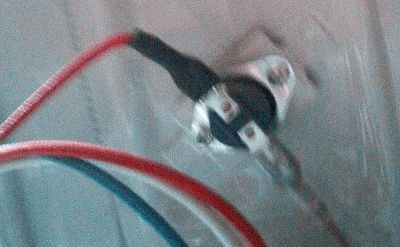

Emergency shutdown sensor (thermal fuse, relay)
- A container filled with oil. Appearance - a poured accordion, heating up to a decent temperature, wait a moment to touch it with your hand. When it comes to drying things, put heat-tolerant ones fearlessly. The container is sealed, but there is 15% air inside. Try to put the oil heater upside down, roll it on one side, return the load to the wheels. Heard thuds scare mice: air bubbles burst inside. Water is not used by the heater, it will quickly evaporate, the corrosion of the body will become significant, the manufacturing technology would require the complete exclusion of air from the working fluid (water + oxygen = the most powerful oxidant of living nature). The coefficient of thermal expansion of the most common liquid on the planet is ten times that of steel. It's not good if the tank bursts.
- The lower part of the end of the accordion contains a heating element, to which the electronics compartment clings. The oil heater has no pump and works by natural oil recirculation. The current starts from the heating element upwards, then at the opposite end of the battery the liquid goes down. While working, it emits the vibration of the spiral, which is audible, under the influence of alternating voltage. The effect is unavoidable, due to the influence of the Earth's magnetic field. The boiling point is above 100 ºС (150-200), avoid touching the container, until the phase state changes, the liquid is not brought due to the prohibition of the use of water: the container will rupture. TEN double (two spirals), will allow more flexible regulation of heating.
- There is a thermal fuse not far from the heating element. The device will not allow a fire to happen, if suddenly oil leaks out, the temperature relay breaks. The oil heater would work hard when the copper heating element began to melt. Oil will leak out - high temperature through the housing will trigger the stuck-on thermal fuse. The structure distinguishes between bimetallic (reusable) or wire (disposable). The photo shows the presence of a clearly blackening tablet above the heating element: a thermal fuse (see the first photo of the review), or a thermal relay (determined by the design).
Steel profile connecting the electronics compartment and the heater accordion
- The relay is located at the top. The main difference from the iron is visible: there is no contact with the body. It can be seen that the thermal relay simply tramples the air. An oil heater resembles an electric kettle in a marked feature, in which the bimetallic plate is often exposed to steam penetrating through a special opening in the body.A thermal relay is an adjustment mechanism, a thermal fuse is designed to localize the case of failure of standard equipment.
- The pictures show: there are two switches, each has a phase, the ground of the heating element, one wire of the thermal relay. This redundancy allows the indicator lamps to glow. One phase is not enough to provide the Joule-Lenz effect. The manufacturer does not know in advance which side the user will plug in the plug, whether the blue (red) wire will be neutralized, and is exposed to 230 volts.
The electrical part differs little from an iron, an electric kettle, a water heater. You can turn on both spirals of the heating element at the same time, separately. In the latter case, the oil heater will take longer to reach the mode. There is a chance that in a cold room, the structure will work without interruption at all.
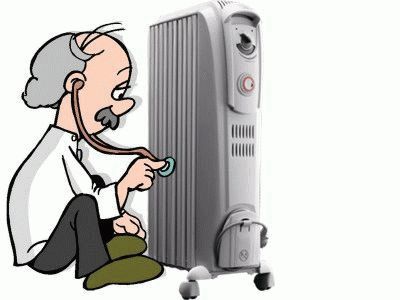

Earth's magnetic field researcher listens to the whirring of the oil heater coil
Close the air passage holes in the electronic circuit - nothing will burn, the oil heater will turn off ahead of time, restart will not take place soon, a drying woolen sock will prevent the flow of a fresh jet. The bottom of the casing of the electronic unit is cut with supply slots. The air leaves the floor, it follows, bypassing the wires, reaching the upper exit. Along the way, the bimetallic plate estimates the moment when heating stops.
Advantages and disadvantages of oil heaters
At the beginning, we talked about the fact that such oil heaters are quite popular. Probably everyone saw them at someone's place or had them at home. Why are they so good? Let's take a look at the positive aspects of oil products:
- Availability. The devices themselves have a reasonable price, which allows you to purchase it for yourself.
- Easy to operate. To turn it on, you just need to plug the wire into the outlet, and your oil heater will start working.
- Mobility. Some models have castors, thanks to which you can place the unit in any room or room. And without them, the process is simple. The oil heater can be carried over.
- No repairs or maintenance is required. An oil heater can work without revision for many years.
- If you use the device correctly, then it will serve you for many years.
- The appearance of the products is also pleasing. Today they are made stylish, beautiful and ergonomic.

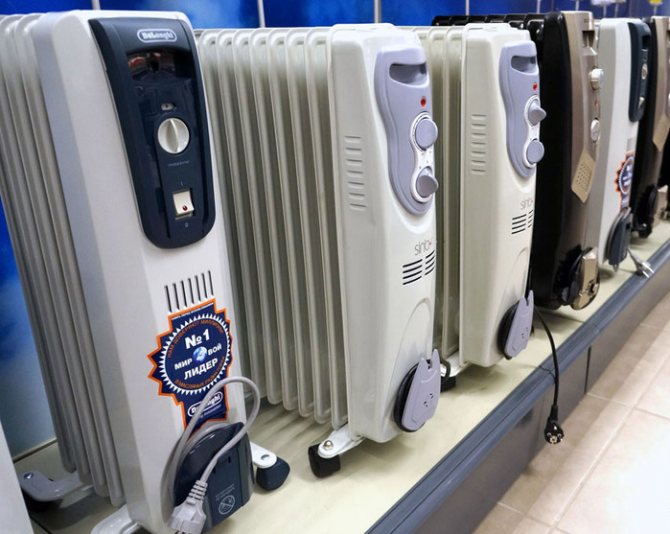
- The oil heater does not take up much space, as it is small-sized.
- With it, your room will heat up pretty quickly. The oil itself inside after turning on quickly heats up.
- Uncomplicated and understandable control system.
- The oil cooler makes no noise during operation. Only an oil heater with a fan can make a low noise.
- There are no combustion products in the heating process, which means that the environment is not polluted.
- The fire safety index of oil heaters is quite high.
- The peculiarity of the heating element is that by turning off the power, it will cool down for some time, heating the room.


But, even the best oil heater has its drawbacks:
- the oil heater is electric, so the use of the device will affect the consumption of electricity, which is not so cheap;
- the case can reach high temperatures. Some oil heaters produce temperatures as high as 150 ° C. Therefore, you can easily burn yourself on the body. And if you install it near flammable objects, it can cause a fire;
- products dry the air. Dry air can have a negative impact on your health.


If we compare these indicators, it becomes clear that oil heaters are an excellent solution. If you are looking for similar units, then we recommend that you stop at this option. But how to choose the right model for yourself if there are a large number of similar products on the market?
Disassemble the oil heater
The photographs of the oil heater show: the electronic unit is sealed in one piece with the accordion. This is not true. Do not cover hides a pair of screws, the retaining bracket is held in place by a spring in the bottom. It is clearly visible with the naked eye, explanations are unnecessary:
- the spring is unfastened;
- the bolts are unscrewed.
Inside the casing of the oil heater, most of the electrical connections are made with detachable terminals. If necessary, remove the switches, the bimetallic relay by unscrewing the screws from the inside, disconnecting the wires. Please note: the heating element is tightly sealed. Shows the desire of manufacturers not to allow anyone inside.


The cunning technician knows how to get to know each other
Repair of oil heaters: the most common causes of malfunctions
Oil heaters are considered to be the most reliable, strong and durable appliances, but they may require repairs.
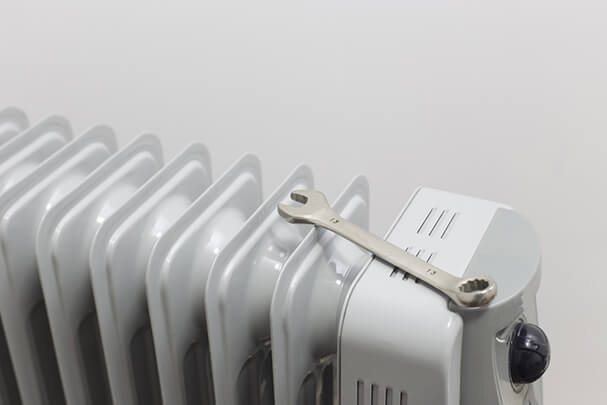

When it comes to additional space heating, oil heaters are considered the most reliable, durable and durable devices for this. However, they can also fail over time. Then the question arises whether it is worth repairing oil heaters with your own hands, or it is better to seek help from professionals. There is another option - just get rid of the faulty unit. Let's find out how realistic it is to fix the device, and whether it is worth spending energy, time and material resources on it.
How to repair an oil heater
- Why does the heater not work?
- Internal structure
- Heater repair from A to Z
- Restoring the integrity of the hull
Why does the heater not work?
If we compare a non-working heater with a sick person, then first of all it is important to make a correct diagnosis. Only after finding out the cause of the breakdown, you will understand how to repair the device, returning it to working capacity.
The most common causes of breakdowns can be divided into several categories:
- after switching on, the device emits a crackling sound. This sound does not mean that the appliance is defective. Most likely, the oil inside the appliance is gradually warming up. In addition, the recent fall of the heating device may be the cause of the crackling. To solve this problem, you need to place the heater on a horizontal surface without a slope;
- the heater does not turn on. First of all, pay attention to the outlet and, if it works, focus on the wiring of the heater itself. Most likely, the contact has gone somewhere: either inside the cord or in the plug;
- the heater turns on but does not heat. That is, visually, the radiator seems to be working - its bulbs are on and the noise of the fan is heard - but it does not produce heat. This indicates that the thermostat has broken. A home master can easily cope with such a repair on his own;
- the heater does not heat up. Another likely cause of a malfunction may be a failure of the heating element (heating element).
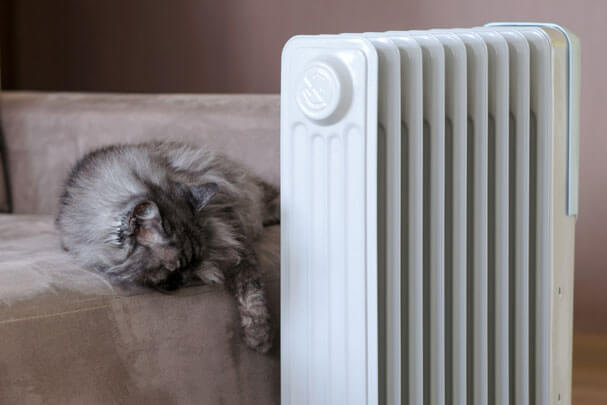

Internal structure
When you have a little understanding of the probable causes of failure of a heater filled with oil, it's time to take a closer look at its design.
A standard modern oil cooler consists of the following elements:
- sealed housing. It is made in the form of an accordion, which consists of two panels welded to each other. Mineral (technical) oil is pumped inside. In almost every heater model, there is a little air inside the oil tank - this is a necessary condition, since when heated, the oil expands, increasing in volume. Note that this circumstance cannot harm the device by provoking corrosion;
- Heating element. This device is responsible for heating the oil, and therefore the device itself;
- safety and control unit.Its main element is a thermostat equipped with a fuse. The first is responsible for setting and maintaining the set temperature, and the second ensures the safe operation of the heating device. If, for some reason, oil begins to ooze from the case, the fuse will fulfill its "mission" by stopping the supply of current to the heating element.
Heater repair from A to Z
Looking at the oil heater with the naked eye, the consumer may think that this device is one-piece, that is, its body with the electrical unit are welded together using the rolling method. But this is not entirely true. Take a look at the “Do not cover” sign, directly below it you will notice several screws that secure the cover to the case. You will have to unscrew these screws, but the cover will not come off immediately, because a spring holds it from the inside. Remove the spring, then you can easily remove the panel.
Now you need to diagnose the heating element. Looking at it more closely, you will see that this part of the oil cooler is sealed hermetically, and this is no accident. Manufacturers have made sure that users of household appliances do not have access to heating elements. The fact is that heating elements rarely break down, they work for many years. So, it is not recommended to try to unwind them once again.
Suppose that one of the heating elements is out of order. Where can such a device be repaired? The answer is not comforting: it will not work either at home or in the workshop to weld the heating element to the body so that the structure becomes airtight again. The result of such a repair is oil dripping from the tank, which can provoke serious problems!
How to repair a heater? For preventive maintenance, you can treat the connection elements of the device with alcohol. In all radiator models, they are in the form of terminals, so you should not have any problems with disconnecting, cleaning and connecting these parts of the unit. It is important to be careful not to make a mistake when connecting the wires to the terminals.
Exactly the same considerations should be followed when it comes to a malfunction of the power supply and elements responsible for safety. Please note that it is not so easy to make a high-quality repair of these parts of the radiator.
Of course, there are tons of training videos on the net with detailed instructions on how to disassemble and fix the above-mentioned components, but if you do not have such experience, it is better to simply replace them with new ones. In this case, everything is simple - they are fixed on brackets or screws, so that you can dismantle it without any problems.
Important: when assembling the oil heater, be careful not to confuse the wires. Remember that the radiator wiring is the basis for its correct operation.
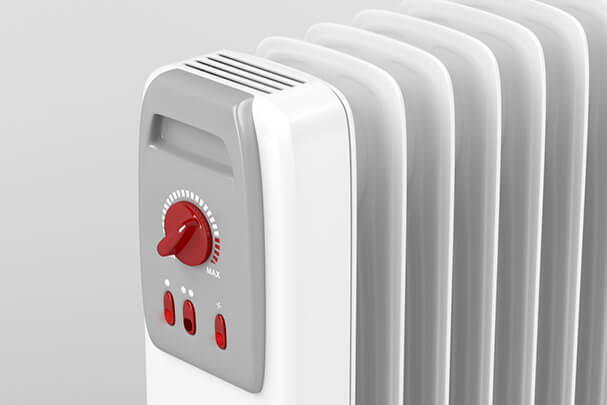

Restoring the integrity of the hull
Let's talk about repairing the radiator tank. In principle, it, like the heating element, is not advised to be repaired at home. If you still want to fix a breakdown associated with the tightness of the oil tank, then pay attention to our recommendations.
The first step is to drain the oil. Pay attention to what kind of oil the tank is filled with. This is important, since during the repair process, although a small part of it, it will spill, and you will have to make up for the losses.
Important: it is forbidden to mix mineral oil with synthetic one.
Metal cases of radiators are sealed in two ways: they are soldered or welded. In this case, welding is a more reliable option, but not everyone has the opportunity to perform this manipulation.
Let's take a closer look at soldering. Take copper-phosphorus, silver or brass solder, tin can not be used! Take care of the presence of a burner, and when you are soldering, pour water into the tank. When the work is over, dry the inside of the tank. Please note that untreated oil must not be poured into the heater.It is important to evaporate it at a temperature that does not exceed +90 degrees. If the oil is heated more, it will begin to oxidize.
Summing up, we note that an independent repair of the oil cooler is quite possible. However, is it worth doing this? As you can see, this is a laborious process that requires adherence to strict safety regulations. The cost of this heating device is not so high, and usually it serves for a long time without any complaints.
Therefore, if you have the opportunity, it is better to buy a new radiator. Suppose you want to inspect the electrical part of the device at your leisure, or practice welding the tank - go for it, just follow the recommendations above. published
Subscribe to our Yandex Zen channel!
If you have any questions on this topic, ask the specialists and readers of our project here.
P.S. And remember, just by changing your consumption - together we are changing the world! © econet
Major breakdowns of oil heaters
The heating element breaks more often, the tank leaks. The oil heater becomes completely unusable. The relay will last for years. Today, Soviet irons are widespread, they are still workable. It is impossible to repair the mechanism. It is necessary to clean oxidized contacts with alcohol. Repair of electronic filling is limited to the replacement of elements mainly. Thermal fuses are too lazy to repair: it is difficult to calculate the response temperature. Masters avoid taking responsibility. Keys, relays should be cleaned from time to time.
General arrangement of oil heaters
The design of oil-filled heaters is a sealed metal heat exchanger-radiator filled with 80% of its volume with oil. A tubular electric heater (or several heating elements) is mounted in the lower part of the radiator, and on the side outside there is a block with control devices (switch, power mode switch, thermostat flywheel) and devices that ensure operational safety (electrical circuit breakers in case of overheating, overturning or filler leakage).


Oil-filled electric heaters of industrial production: on the left - ribbed, on the right - flat.
The equipment of oil heaters, depending on the type and performance class of the unit, is different, but an oil-filled radiator with heating elements is present in all devices.
The tubular heater, after being connected to the network, increases the temperature of the oil in the lower part of the radiator, thereby initiating the formation of convective flows in this liquid medium. Thanks to convection, the device heats up evenly over the entire surface area and gives off heat to the air, which as a result also starts convection movement.
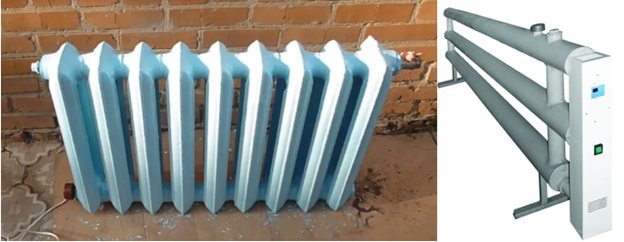

Homemade oil heaters
The heating of the contents of the radiator is accompanied by the expansion of the liquid and, accordingly, an increase in the pressure in the reservoir. Part of this effect is extinguished by the air "cushion", which occupies 20% of the radiator's volume, but its remainder still presses on the walls of the container from the inside. The radiator of the new oil heater is designed for such a load, but due to a number of factors, sooner or later it may lose its tightness. Consider how to eliminate this malfunction in relation to various types of oil-filled heaters.
Finned heater
Radiators of such heaters are similar in configuration to cast-iron central heating heat exchangers. Separate sections of such heaters are made from workpieces cut with high precision by laser from sheet steel with a thickness of 0.5 mm, molded by pressing and then assembled by laser welding again.
The small thickness of the radiator walls makes the heater vulnerable to corrosion, therefore, a protective powder painting is performed on the outside of the casing of such oil heaters.Mechanical damage to the protective layer, which is common in everyday life, entails, first, a point surface, and then through corrosion of the tank with a loss of tightness.


Progressive corrosion of the rib of the oil-filled heater section
When depressurizing a ribbed oil cooler, three problems have to be solved:
- elimination of damage to the case;
- filling the reservoir with oil;
- restoration of the tightness of the container.
The possibility of repairing a radiator is primarily determined by the design of its heating element.
Important! If the heating element is rolled into the housing, the heater cannot be repaired due to the absence of a technological hole for filling the tank with oil after its tightness is restored.
If the tubular heater is removable, then dismantling it allows you to drain the remaining oil after the leak, repair the damage, then refill the radiator, and reinstall the heating element.
Replacing the heating element and reassembling the oil heater
It should be noted that there are no gaskets between the heating element and the body. The tightness of the connection is achieved with a cone on the thread. But the master also has to take into account something. For example, the seat on the heater body must be thoroughly wiped with a clean cloth. You should also make sure that there is no debris on the heating element that can lead to oil leakage.
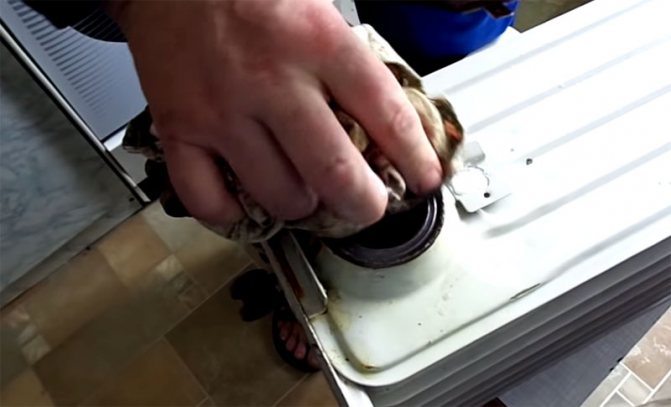

The seat must be thoroughly wiped
Installing a new heating element
The new heating element is first screwed into the body by hand until it stops, after which the gas key again comes into play. It should be tightened as long as there is enough strength. After the new heating element is pulled out, the heater is set to the operating position. So it should stand for at least 4-5 hours, so that you can make sure that there is no oil leak. Only after passing this test can the entire heater be assembled.
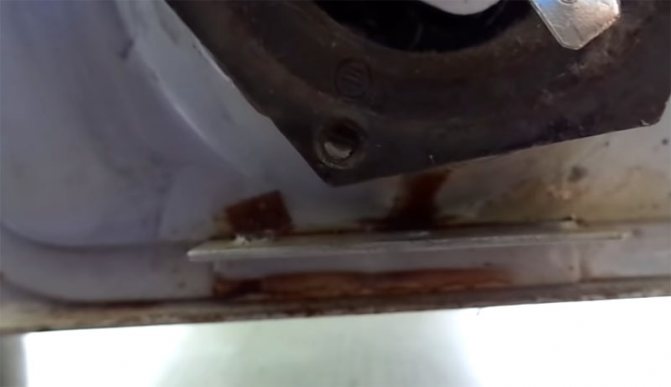

After a few hours of testing, the case should remain dry.
Electrical part: connecting TENA to automation
In the case described today, the new heating element turned out to be a little different from the failed one in terms of the form of contacts. The connections of the old heating element were screw, and on the new one they were “mom-dad” chips. If something like this happened, then there is nothing wrong with that. You just need to cut off the old rings from the wires and press the "mom" chips onto them. It is not difficult to do this, the kits necessary for such work are inexpensive. At the same time, they will always be useful not only when working with household appliances, but also when repairing a car's electrical network.


Crimping the tip chips using a special tool called a crimper
Installation of an emergency disconnect switch
A white substance can be seen in the seat of the breaker, as well as on its body. It is a thermal paste that helps to distribute the temperature evenly. Before screwing the breaker into place, you need to smooth out the thermal grease to increase the tightness of the connection.
The emergency disconnect switch is screwed to the body as tightly as possible - this determines its performance in case of overheating.
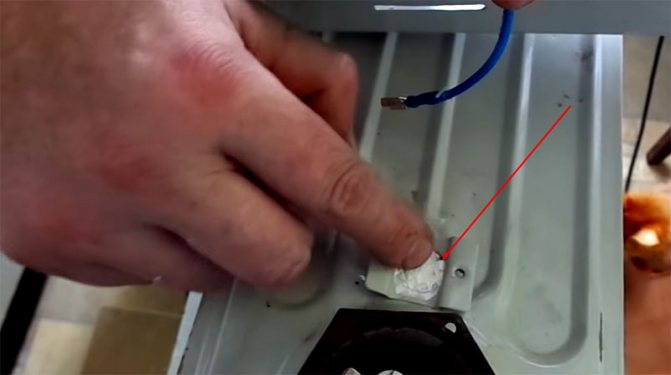

Thermal grease should be smoothed with your finger before installing the emergency release
It remains only to connect the power wires of the heating element according to the marking and close the cover, fixing it with 4 screws. This completes the work of replacing the heating element. But there is still a final test of performance ahead.
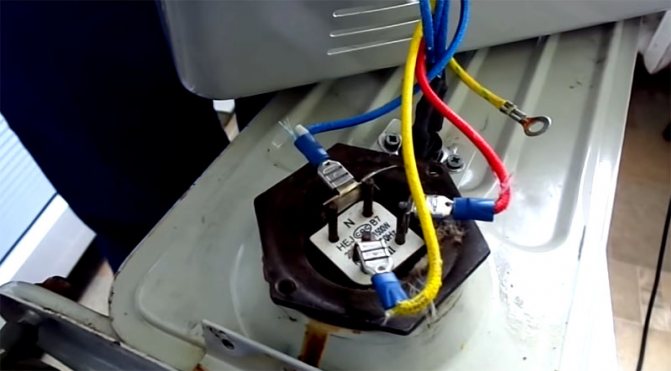

The wires are in place, you can close the cover and start checking the heater's performance
